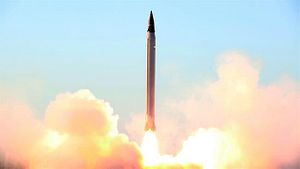Iran has recently successfully test-fired a new precision-guided, long-range surface-to-surface missile, Iranian state TV reported on Sunday.
While details on the precise nature of the test remains murky, Iran’s Defense Minister Hossein Dehghan told Fars New Agency that the new missile, named Emad (Pillar), “is able to strike targets with a high level of precision and completely destroy them… This greatly increases Iran’s strategic deterrence capability.”
The precise timing of the test is unknown as is the exact induction date of Iran’s newest missile. Dehghan merely mentioned that the new long-range weapon will enter service in the “near future.”
The defense minister additionally noted that the Emad is “the country’ first long-range missile with navigation and strike controlling capability” and can hit targets “with high precision.”
The Emad missile is a single-stage, liquid-propelled medium-range ballistic missile and a derivative of the Shahab-3, according to a CSIS study: “It is essentially a Shahab-3, but with a maneuvering reentry vehicle to improve system accuracy and complicate missile defense.”
The study estimates that the missile has a range of 1,700 kilometers (1,056 miles) and can carry a payload of 750 kilograms (1,653 pounds). The Emad is also supposedly road-mobile and can be fired from a mobile launcher.
Furthermore, the report points out that Iran might be working on a nuclear warhead for its Shahab-3 missile arsenal, which would make it likely that the Emad could also be fitted with a nuclear warhead.
The Shahab-3 itself is purportedly based on the North Korean No Dong 1 missile design. ”The original Shahab 3 missile is nearly identical to the North Korean No Dong 1 missile, and almost certainly is based on technology and parts from North Korea,” according to the website Missile Threat.
Should Iranian statements prove correct, Tehran would for the first time be in possession of a precision-guided missile with the range to hit Israel.
However, Missile Threat cautions:
The abilities and specifications of the Shahab 3 are largely based upon foreign speculation and aggressive Iranian diplomacy. Iran is known to rename missile programs, exaggerate about missile performance abilities, and declare that untested technologies are operational.
The CSIS study concurs and adds:
Iran has not conducted extensive, realistic missile tests at full operational ranges and carried through to strikes on target with the same configuration of its modified or Iranian-produced missiles to make reliable estimates of their war fighting capability.
The CSIS reports additionally points out that “Iran has a tendency to introduce similar missiles under different names, exaggerate missile performance, exaggerate the number of missiles used in tests, and actively doctor reports of firings and their results.”
It is in particular highly doubtful that Iran has mastered the maneuvering reentry vehicle technology. Thus statements by Iranian state TV that the Emad is “capable of scrutinizing the targets and destroying them completely” should perhaps be taken with a grain of salt.
































